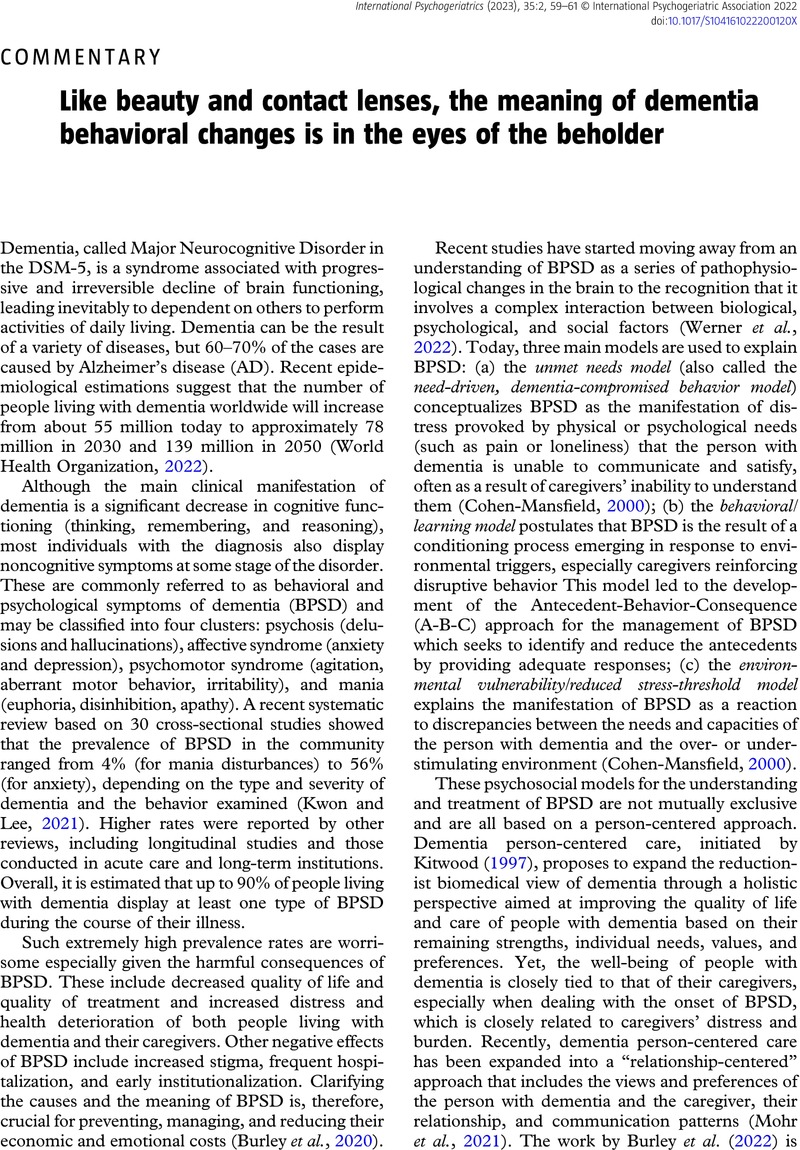No CrossRef data available.
Article contents
Like beauty and contact lenses, the meaning of dementia behavioral changes is in the eyes of the beholder
Published online by Cambridge University Press: 21 December 2022
Abstract
An abstract is not available for this content so a preview has been provided. Please use the Get access link above for information on how to access this content.

- Type
- Commentary
- Information
- International Psychogeriatrics , Volume 35 , Special Issue 2: Issue Theme: Families’ Emotional Involvement in Caregiving , February 2023 , pp. 59 - 61
- Copyright
- © International Psychogeriatric Association 2022
References
Burley, C. V., Casey, A. N., Chenoweth, L. and Brodaty, H. (2022). Views of people living with dementia and their families/care partners: helpful and unhelpful responses to behavioral changes. International Psychogeriatrics, 35, 77–93. https://doi.org/10.1017/S1041610222000849.CrossRefGoogle ScholarPubMed
Burley, C. V., Livingston, G., Knapp, M., Wimo, A., Norman, R. and Brodaty, H. (2020). Time to invest in prevention and better care of behaviors and psychological symptoms associated with dementia. International Psychogeriatrics, 32, 567–572. https://doi.org/10.1017/S104161022000037X.CrossRefGoogle Scholar
Cohen-Mansfield, J. (2000). Theoretical frameworks for behavioral problems in dementia. Alzheimer’s Care Quarterly, 1, 8–21. https://hsrc.himmelfarb.gwu.edu/sphhs_prev_facpubs/451
Google Scholar
Cunningham, C., Macfarlane, S. and Brodaty, H. (2019). Language paradigms when behaviour changes with dementia: #BanBPSD. International Journal of Geriatric Psychiatry, 34, 1109–1113. https://doi.org/10.1002/gps.5122.CrossRefGoogle ScholarPubMed
Fazio, S. et al. (2020). What is really needed to provide effective, person-centered care for behavioral expressions of dementia? Guidance from the Alzheimer’s association dementia care provider roundtable. JAMDA, 21, 1582–1586. https://doi.org/10.106/j.jamda.2020.05.017.Google ScholarPubMed
Gilmore-Bykovskyi, A., Mullen, S., Block, L., Jacobs, A. and Werner, N. E. (2020). Nomenclature used by family caregivers to describe and characterize neuropsychiatric symptoms. The Gerontologist, 60, 896–904. https://doi.org/10.1093/geront/gnz140.CrossRefGoogle ScholarPubMed
Kales, H. C., Gitlin, L. N. and Lyketsos, C. G. (2015). Assessment and management of behavioral and psychological symptoms of dementia. BMJ, 350, h369. https://doi.org/10.1136/bmj.h369.CrossRefGoogle ScholarPubMed
Kitwood, T. M. (1997). Dementia Reconsidered: The Person Comes First. Buckingham: Open University Press. https://bit.ly/34eQlkj
Google Scholar
Kwon, C. H. and Lee, B. (2021). Prevalence of behavioral and psychological; symptoms of dementia in community-dwelling dementia patients: a systematic review. Frontiers in Psychiatry. https://doi.org/10.3389/fpsyt.2021.741059.CrossRefGoogle ScholarPubMed
Mohr, W. et al. (2021). Key intervention categories to provide person-centered dementia care: a systematic review of person-centered interventions. Journal of Alzheimer’s Disease, 84, 343–366. https://doi.org/10.3233/JAD-210647.CrossRefGoogle Scholar
National Institutes of Health. (2022). Recommendations from the NIH AD research summit 2018. Available at: nia.nih.gov/research/administration/recommendations-nih-ad-research-summit-2018; last accessed 30 November 2022.Google Scholar
Schwertner, E. et al. (2022). Behavioral and psychological symptoms of dementia in different dementia disorders: a large-scale study of 10,000 individuals. Journal of Alzheimer’s Disease, 87, 1307–1318. https://doi.org/10.3233/JAD-215198.CrossRefGoogle ScholarPubMed
Sefcik, J. S. et al. (2020). Person-centered care plans for nursing home residents with behavioral and psychological symptoms of dementia. Journal of Gerontological Nursing, 46, 17–27. https://doi.org/10.3928/00989134-20201012-03.CrossRefGoogle ScholarPubMed
Warren, A. (2022). Behavioral and psychological symptoms of dementia as a means of communication: considerations for reducing stigma and promoting person-centered care. Frontiers in Psychology, 13, 875246. https://doi.org/10.3389/fpsyg.2022.875246.CrossRefGoogle ScholarPubMed
Werner, P., Ulitsa, N., Shephet, D., Abojabel, H., Alpinar-Sencan, Z. and Schicktanz, S. (2021). Fear about Alzheimer’s disease among Israeli and German laypersons, persons with mild neurocognitive disorder and their relatives: a qualitative study. International Psychogeriatrics, 33, 1019–1034. https://doi.org/10.1017/S1041610220003397.CrossRefGoogle ScholarPubMed
Werner, P., Vermeulen, P., Van Gorp, B. and Simonsen, P. (2022). From history to intervention: a socio-cultural analysis of dementia stigma. In: Vandenbulcke, M., Dröes, R. M. and Schokkaert, E. (Eds.), Dementia and Society: An Interdisciplinary Approach (pp 25–42). Cambridge: Cambridge Press.CrossRefGoogle Scholar
Wolverson, E., Moniz-Cook, E., Dunn, R. and Dunning, R. (2022). Family carer perspectives on the language of behavior change in dementia: an online mixed methods survey. Age and Ageing, 51, afac047. https://doi.org/10.1093/ageing/afac047.CrossRefGoogle ScholarPubMed
World Health Organization. (2022). Facts sheets of dementia. Available at: https://www.who.int/news-room/fact-sheets/detail/dementia; last accessed 20 November 2022.Google Scholar




